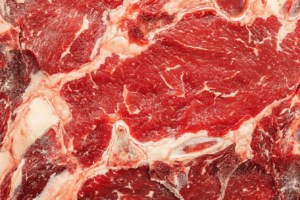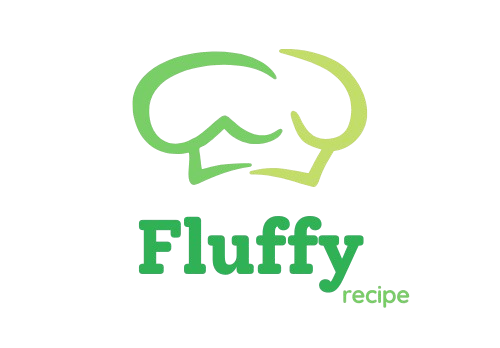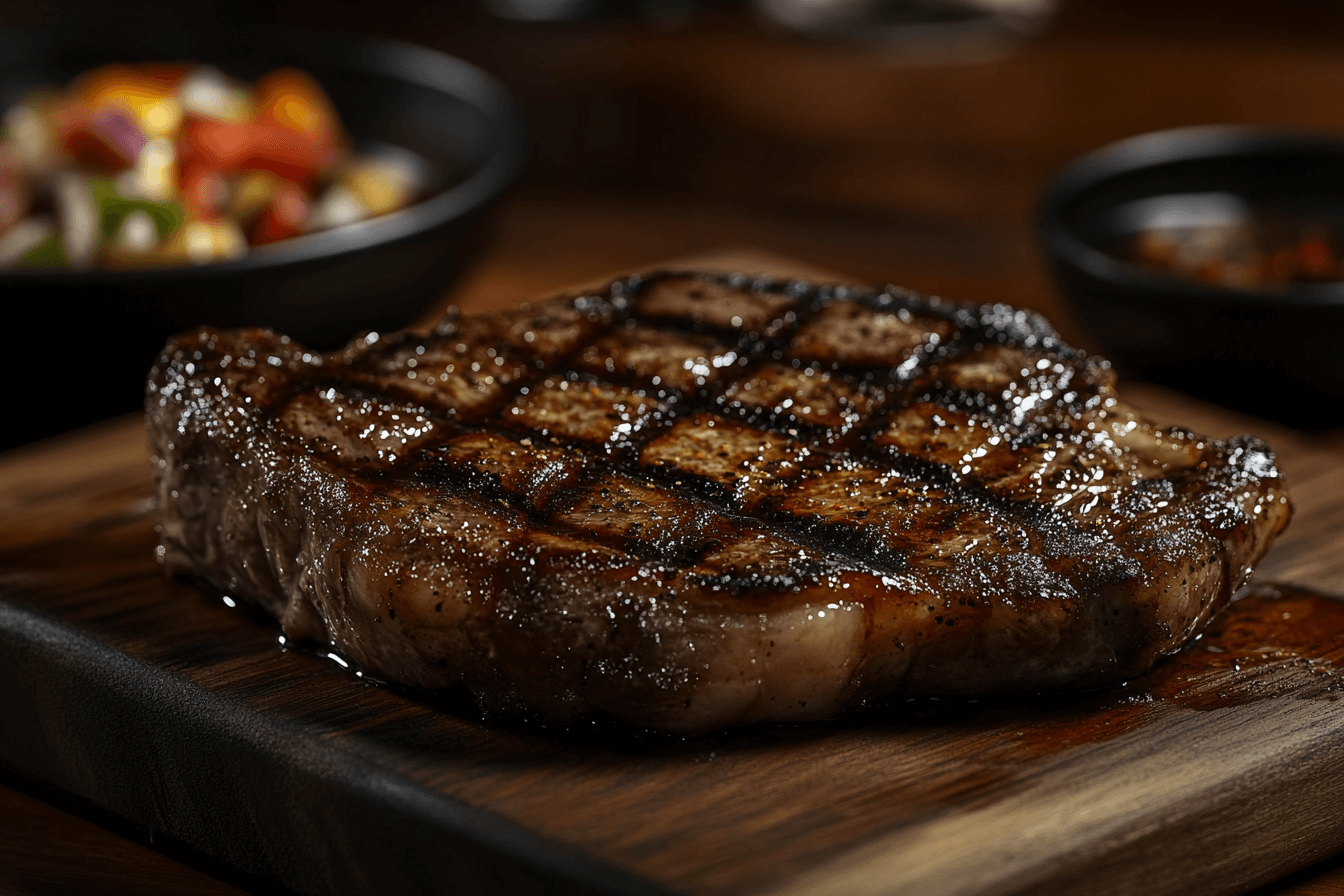Cowboy steak, also known as a bone-in ribeye or tomahawk steak, often creates a buzz among steak lovers. Many wonder why a single piece of meat can cost so much. Yet, the price tag does not stop curious foodies from reaching for their wallets. This special cut, with its impressive appearance and deep flavor, has a reputation that goes far beyond your usual ribeye. Moreover, it’s a favorite for those seeking a grand meal that leaves a lasting impression.
In this article, we will explore the factors behind the high price of cowboy steak. We will also discuss how to choose and cook this delicious cut. Furthermore, we will answer common questions about cowboy steaks, including whether they are worth the expense. Our journey will show you why so many people pay top dollar for this hefty, flavorful steak.
Understanding the Cowboy Steak (Bone-In Ribeye)
A cowboy steak is essentially a thick-cut ribeye with a section of the rib bone still attached. Often called a tomahawk steak when the bone is left extra long and “Frenched,” it makes quite a statement on any dining table. But what sets it apart from the usual ribeye you see at the grocery store?
First, its size is much larger than a standard ribeye. A typical cowboy steak can weigh between 1.5 to 2.5 pounds. Sometimes, it can weigh even more. Additionally, its bone structure adds an attractive look and serves as a flavor enhancer during cooking. In contrast to boneless ribeyes, the cowboy steak’s bone insulates part of the meat and can help boost juiciness.
Where the Cowboy Steak Comes From
This cut comes from the rib section of the cow. Specifically, it is taken from ribs six through twelve on the upper back portion of the steer. The rib section is home to some of the tenderest and fattiest cuts. Thus, the cowboy steak inherits a generous amount of marbling.
Because of its origin, it brings together tenderness and bold flavor in one package. Furthermore, the bone attached to the steak often includes extra meat around it, which is a treat to eat. When properly cooked, you can savor a balance of buttery texture and hearty flavor.
Why Is Cowboy Steak So Expensive?
This question does not have a single answer. Instead, several factors come together to raise the price of this cut.
Limited Availability of Bone-In Ribeye
One main factor is its limited availability. Each cow has a finite number of rib sections that can be cut into cowboy steaks. When you buy this steak, you are paying for a specific portion of the animal. Moreover, butchers must devote extra time and skill to prepare a perfectly trimmed cowboy steak. This additional labor raises its market value.
Additionally, many steakhouses prize this cut for its commanding presentation on a plate. Demand from upscale restaurants can drive up prices even more. Consequently, when top dining spots compete for these steaks, the cost rises across the board.
Premium Marbling and Quality
Marbling refers to the thin white streaks of fat found within the meat. The cowboy steak’s marbling contributes greatly to its rich flavor and succulent texture. In general, meats with extensive marbling fetch higher prices.

Also, some premium cattle breeds, such as USDA Prime or Wagyu, push these prices even further. When you add terms like “dry-aged” into the mix, the price can soar. Dry-aging intensifies flavor and tenderness, but it also involves time and storage, which adds cost.
Time and Effort in Production
Raising high-quality cattle takes significant investment. Farmers must feed and care for their livestock, ensuring they develop the right amount of muscle and fat. Moreover, they need enough space for their cattle to roam and rest. Grain-fed or grass-fed methods also impact the overall cost.
Transporting and storing large cuts of beef is another factor. Furthermore, strict health regulations and inspections can add to operating costs. Thus, every step in the journey, from farm to butcher to grocery store or steakhouse, contributes to the final price tag.
Showcase Cut
The cowboy steak’s presentation plays a big part in its cost. This steak is often served as a “showstopper” due to its large size and dramatic bone handle. Many diners enjoy the spectacle that comes with a massive tomahawk steak hitting their table.
Such visual appeal drives up demand for these cuts. They are seen as luxury items, suitable for special events. As a result, butchers can charge more. After all, a good show often has a higher price.
Marketing and Brand Appeal
Many steakhouses and gourmet meat suppliers frame the cowboy steak as a specialty item. This kind of marketing can influence consumer perception. When people associate a product with luxury or exclusivity, they are prepared to pay more.
Although the flavor, texture, and size justify a higher cost, branding also plays a role. Chefs promote these bone-in ribeyes as the ultimate steak experience. Consequently, many home cooks view them as a rare treat.
How to Choose the Best Cowboy Steak
Selecting the right cowboy steak can be overwhelming. However, a few guidelines can simplify the process.
Look for Ample Marbling
Marbling is a key indicator of flavor and tenderness. You want to see thin streaks of fat running throughout the meat. Avoid cuts that have large chunks of exterior fat and little to no interior marbling.
Additionally, be sure the steak has a bright, cherry-red color. This suggests freshness and good handling.
Thickness and Bone Length
Typically, a good cowboy steak is about 1.5 to 2 inches thick. Some can be thicker, but thinner cuts may not cook as evenly. The length of the bone is a personal preference. A longer bone gives a tomahawk-like appearance, which some people love for its dramatic look.
When picking your steak at the butcher shop, ask if you can see the bone. A clean, white bone is often the result of a good “Frenching” process. Also, ensure there are no cracked or splintered areas.
Grade and Source
In the United States, the USDA grading system helps determine meat quality. Prime is the highest grade, offering excellent marbling. Choice is right behind Prime and can still be very good. Select has the least marbling among the top three grades.
Many specialty suppliers offer Wagyu cowboy steaks as well. These can be extremely pricey, but they deliver a rich, buttery taste that is hard to find elsewhere.
Fresh vs. Dry-Aged
When you visit specialty butcher shops, you may find dry-aged cowboy steaks. Dry-aging can last from two weeks to over a month. This process removes moisture and intensifies flavor. However, it also leads to weight loss for the cut, making it even more expensive.
If you crave a strong, earthy flavor, a dry-aged steak might be worth the extra cost. But if you prefer a more classic taste, a fresh cowboy steak still delivers plenty of flavor.
Cooking and Serving Tips for a Cowboy Steak
Once you invest in this premium cut, you want to cook it right. Whether you grill it, sear it in a cast-iron skillet, or roast it in the oven, there are a few guidelines to keep in mind.

Preparation and Seasoning
Pat your steak dry with paper towels to remove excess moisture. Then, season it generously with salt and pepper. You can also add garlic powder, paprika, or your favorite spice rub.
Additionally, let your steak sit at room temperature for about 30-45 minutes before cooking. This step helps it cook evenly.
Cooking Methods
- Grilling: The grill imparts a smoky taste. First, sear both sides of the steak over direct high heat. Then, move it to indirect heat to finish cooking.
- Cast-Iron Searing: Heat a cast-iron skillet until very hot. Add a touch of oil, then sear the steak on each side. Lower the heat, add butter and aromatics, and baste the steak.
- Oven Roasting: Preheat your oven to 400°F. Sear the steak in a hot skillet first, then transfer it to the oven. Cook it until the internal temperature reaches your desired doneness.
Regardless of the method, use a reliable meat thermometer. For medium-rare, aim for an internal temperature of about 130-135°F.
Resting and Slicing
Once the steak reaches your preferred temperature, remove it from the heat and let it rest. Resting allows the juices to redistribute, ensuring you don’t lose flavor when you slice it. Generally, a rest of 10-15 minutes is ideal.
To carve, slice against the grain for maximum tenderness. Cut along the bone to separate it, then portion the meat if you’re sharing.
Serving Suggestions
Cowboy steak is rich and full-flavored, so simple sides pair best. A crisp salad, roasted vegetables, or a light pasta dish work well. Additionally, a savory sauce like chimichurri or a classic red wine reduction can elevate the experience.
Furthermore, consider pairing it with a bold red wine if you enjoy wine with your steak. Alternatively, craft beers with a malty backbone can complement its robust taste.
Health and Nutrition Facts
Cowboy steaks are high in protein and contain essential nutrients like iron, zinc, and B vitamins. However, they also have a high fat content, mainly due to the marbling. Moderation is key if you’re concerned about saturated fats and calories.
When you choose a high-grade bone-in ribeye, you are opting for flavor over leanness. Therefore, if you eat these steaks regularly, keep an eye on portion sizes.
Cost vs. Value
Although cowboy steaks can be pricey, many enthusiasts argue they are worth every penny. After all, you’re paying for:
- Exceptional flavor from the rib section.
- A striking visual display on the plate.
- Limited availability of thick-cut, bone-in ribeye.
- Quality marbling and careful butchering.
Yet, the final choice rests on your personal preference and budget. Some people love the dramatic presentation and juicy bite. Others might prefer a simpler cut like a strip steak for everyday meals.
Because of its special characteristics, the cowboy steak is often saved for celebrations or special events. As such, the higher cost can be justified by the memorable experience it offers.

Frequently Asked Questions
Is cowboy steak a good cut?
Yes, it is a fantastic cut for those who enjoy rich, beefy flavor. The bone-in structure helps lock in moisture, and the marbling ensures tenderness. Additionally, it has a dramatic appearance that makes it a showstopper.
How many people will a cowboy steak feed?
A single cowboy steak can weigh 1.5 to 2.5 pounds. Many people can share one steak, especially if you serve sides. Usually, it can feed two to three people, depending on appetite and portion size.
Are tomahawk steaks overpriced?
They can seem expensive, but their large size, bone-in presentation, and tender meat can justify the cost for special occasions. Moreover, their demand in upscale restaurants can drive up the price.
What steak costs $1000?
Some ultra-premium cuts, such as high-grade Wagyu or Kobe beef tomahawk steaks, can cost around $1000 or more in luxury steakhouses. Often, these steaks come from cattle with specialized feeding programs and extensive marbling, which pushes the price to extreme levels.
Conclusion
Cowboy steak brings a bold presentation and intense flavor to the table. It might seem pricey, but many steak fans believe it is worth every cent. Whether you buy it for a special gathering or simply to explore the world of premium beef, you will likely remember every juicy bite.
Moreover, when cooked with care and properly rested, this bone-in ribeye can outshine many other steak cuts. In the end, the question “Why is cowboy steak so expensive?” has a simple answer: great flavor, show-stopping looks, and high demand all contribute to its steep price tag.
If you ever want to treat yourself and your guests to a memorable meal, this cut is definitely worth considering. Enjoy its robust taste, and savor the experience.

